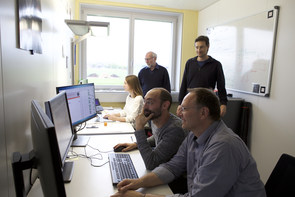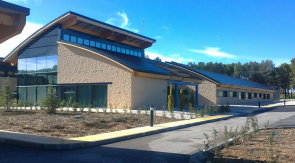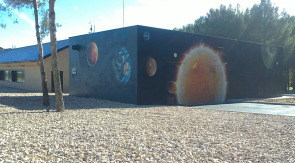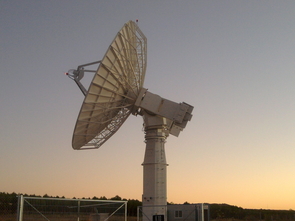#17: Practice makes perfect for CHEOPS inflight operations
25 June 2019
It takes collaboration and teamwork to operate a spacecraft. As the CHEOPS launch approaches, a Europe-wide team is preparing to take control of inflight activities once the satellite is in space. |
| CHEOPS science operations staff in action. Credit: Courtesy of University of Geneva |
Like a Stradivarius violin in trained hands, the finely-tuned CHEOPS satellite will be operated by skilled support staff. In fact, the mission relies on a whole 'orchestra' of purpose-built subsystems to gather and deliver the astronomical data that will enable scientists to investigate planets beyond our Solar System.
The latest phase of the project has involved validating operation procedures and training team members to use the satellite safely and reap the maximum scientific reward.
Routine operations for CHEOPS will be dedicated to observing a selection of stars known to host exoplanets but, before the start of observations, the spacecraft has to perform a vital sequence of post-launch activities.
The first five days after launch, the so-called Launch and Early Orbit Phase (LEOP), will be particularly critical. This is when the spacecraft is progressively powered up and the proper functioning of the platform equipment is verified in real operational conditions. Depending on the accuracy of the actual orbit insertion performed by the launcher, there may be the need to perform orbit correction manoeuvres.
Following LEOP, two months of In-Orbit Commissioning (IOC) will validate the end-to-end performance of the mission – including both flight and ground segments – before routine science operations can begin. The initial part of IOC will focus on confirming the flight performance of the instrument and platform, followed by a final demonstration of the capabilities of both MOC and SOC to routinely operate the satellite.
 |
|
| CHEOPS Mission Operations Centre. Credit: ESA–R. Southworth |
Two operations centres with distinct tasks have been set up to run the mission. Scientific support staff at the Science Operations Centre (SOC) in Geneva, Switzerland, will define weekly plans for the astronomical observations and process the telemetry that is downlinked to Earth. The tools used at the SOC have been contributed from partners across Europe: the mission planning tool, the unpacking software, the data reduction pipeline and the 'quick look' tool were developed in Portugal, Switzerland, France and the UK, respectively.
The processed data will then be analysed in detail after being distributed, via the CHEOPS archive, to the scientists who proposed the respective observations. Spacecraft operators at the Mission Operations Centre (MOC) in Torrejón, Spain, will configure and manoeuvre the satellite according to the observation plan, monitor the spacecraft performance, and ensure that data flows smoothly back to the SOC.
 |
 |
| CHEOPS Mission Operations Centre. Credit: Courtesy of INTA |
CHEOPS Mission Operations Centre. Credit: Courtesy of INTA |
Although the most emblematic element of the CHEOPS mission is the orbiting satellite, the hardware and software installations at the SOC and the MOC are just as essential to the success of the mission. The same can be said of the series of procedures that has been established by the project teams. What has been built is not merely an impressive collection of hi-tech instrumentation and code, but a complex, dynamic system that is more than the sum of its interacting parts.
The aim of the recently completed CHEOPS operational readiness review was to examine the hardware, software, personnel, procedures, interfaces and documentation to confirm that all will function correctly and that the spacecraft can be operated successfully. After two days of intense scrutiny at the beginning of May, a board of experts declared the review a success.
With the hardware and software in place, the best way to reach the level of integration and operator proficiency required for CHEOPS operations is to practice realistic operational scenarios in advance. Such training exercises help prepare team members for the dynamic aspects of the mission.
 |
| CHEOPS ground station antenna at Torrejón de Ardoz. Credit: Courtesy of INTA |
Training rehearsals at the SOC cover all phases of operations. A typical SOC rehearsal starts with a planning meeting to determine the week-long observing schedule that will be translated into a detailed activity plan for the spacecraft (including the science instrument). The team then simulates a transmission of the activity plan to the MOC, followed by the receipt of simulated science data that is unpacked before being processed and later archived. During the rehearsals, unexpected events will be introduced to provide extra challenges to the SOC team.
Operations simulations at the MOC follow a similar template to the SOC rehearsals, but focussing on spacecraft control. Representative scenarios, which also include surprise anomalies, will be played out by the MOC team who will control a software simulator that mimics the behaviour of the satellite. The aim is to demonstrate that all planned operations sequences can be performed by the spacecraft operators in a way that is feasible, safe and time-efficient.
Simulation exercises involve several days of continuous activity. Routine MOC activities include verifying that the SOC activity plan does not violate spacecraft constraints, converting the activity plan into telecommands, and uplinking those commands to the spacecraft. The MOC team will pay special attention to preparing for the time-critical LEOP and the in-orbit commissioning phase. Simulation training is crucial so that team members can work together closely in the earliest phases of post-launch operations.
The recent CHEOPS activities have returned focus to the human factors that are and will remain vital to the mission. As the operation teams in Switzerland and Spain gel together, they are set to capitalise on the work of professionals from nine other consortium countries in an inspiring example of pan-European cooperation enabled by ESA.
ABOUT CHEOPS
CHEOPS is an ESA mission implemented in partnership with Switzerland, through the Swiss Space Office (SSO). The University of Bern leads a consortium of 11 ESA Member States contributing to the mission and represented in the CHEOPS Science Team. ESA is the mission architect responsible for overall mission definition and procurement of the spacecraft and launch. ESA is also responsible for the early operations phase that will be executed by the spacecraft contractor, Airbus Defence and Space–Spain (ASE). The science instrument is led by the University of Bern, with important contributions from Austria, Belgium, Germany and Italy. Other contributions to the science instrument, in the form of hardware or science operations, are provided by Hungary, France, Portugal, Sweden, and the United Kingdom. CHEOPS will be launched from Europe's spaceport in Kourou, French Guiana, on a Soyuz rocket operated by Arianespace. Following successful in-orbit commissioning of the spacecraft, responsibility for operations will be taken over by the CHEOPS Mission Consortium, with the Mission Operations Centre under the responsibility of INTA, Spain, and the Science Operations Centre led by the University of Geneva, Switzerland.





